深入分析梳状滤波器原理Comb-filter
深入分析梳状滤波器原理Comb-filter-精品文档28页

Mode B (2D weighting with bandpass filter)
Normal mode ,Y-C can be separated quite well.
Mode C (2D weighting without bandpass filter)
Reference
谢谢你的阅读
知识就是财富 丰富’ C’
Mode A (detection (1,3) > T3)
Which means the vertical detail defference is serious.
Bandpass filter performs better than comb filter.
Y
Mode B (detection (1,3) < T3)&(detection (2,3) > T2)
y y+c
y-c
2c
c
Why we call it a "comb filter"
2D weighting comb filter
different colors vertically through the picture . (1/4,1/2,1/4). the transition from one color to another is softened.
1.Frequency- notch , bandpass filter ( in early years ).
2.Chrominance phase differencecomb filter ( today ).
Frequency
数字梳状滤波器讲解

数字梳状滤波器梳状滤波对于画面质量是非常重要的一个技术,因此我们有必要对其进行详细刨析。
那么具体什么是梳状滤波器呢?这就要从源头(信号源)开始讲起了,一开始,接收视频的Video端子是Composite端子(比如RF射频接口和AV接口),它所能接收的信号叫Composite Video Signal,即混合视频信号(也称复合信号),什么意思呢?因为这个Composite(混合)信号包括了亮度(Luminance,用字母Y表示)和色度/彩度(Chrominace)两方面的信号,视频电路要做的工作就是Y/C进行分离处理,目前的梳状滤波器是在保证图像细节的情况下解决视频信号亮色互窜的唯一方法,其内部有许多按一定频率间隔相同排列的通带和阻带,只让某些特定频率范围的信号通过,因为其特性曲线象梳子一样,故人们称之为梳状滤波器(Comb Filtering)。
梳状滤波器一般由延时、加法器、减法器、带通滤波器组成。
对于静止图像,梳状滤波在帧间进行,即三维梳状滤波。
对活动图像,梳状滤波在帧内进行,即二维梳状滤波。
高档数字电视机采用行延迟的梳状滤波器与带通滤波器级联,构成Y/C分离方案就可获得满意的图像质量。
使用梳状滤波器能使图像质量明显提高。
解决了色串亮及亮串色造成的干扰光点、干扰花纹;消除了色度正交分量U、V色差信号混迭造成的彩色边缘蠕动;消除了亮、色镶边,消除了高频信号的色彩错误和灰度值表示错误。
有一段时期国内很多工厂(为了节省成本)使用模拟的方式实现梳状滤波器,实际上效果很不好,原因有两个,一是延迟器件的带宽很难保证,二是解决行相关性差问题的自适应电路很复杂。
而在数字电路里,只要有足够的存储器,就可以保证足够的延迟时间与信号带宽,且复杂的自适应电路很容易集成在芯片中硬件固化。
梳状滤波器原理及发展历史:梳状滤波器采用频谱间置技术,理论上可以保证亮度和色度的无失真分离。
如果我们好好回顾一下梳状滤波器的发展历程,将对其有个清醒的认识。
3D_comb_filter滤波器资料
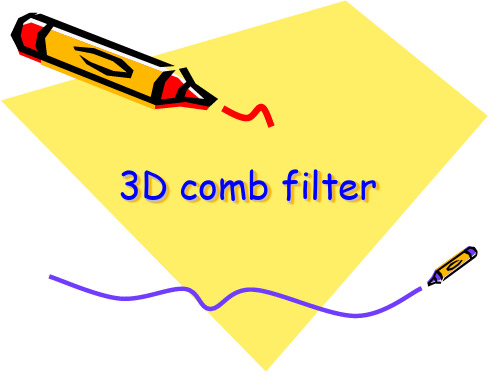
什么是数字梳状滤波器
• 从信号源开始讲起了,由于Video端子是Composite端 子(比如RF射频接口和AV接口),它所能接收的信 号叫Composite Video Signal,即混合视频信号(也 称复合信号.因为这个Composite(混合)信号包括了 亮度(Luminance,用字母Y表示)和色度/彩度 (Chrominance)两方面的信号.而视频电路要做的工 作就是Y/C进行分离处理,目前的梳状滤波器是在保 证图像细节的情况下解决视频信号亮色互窜的唯一方 法,其内部有许多按一定相同频率间隔排列的通带和 阻带,只让某些特定频率范围的信号通过,因为其特 性曲线象梳子一样,故人们称之为梳状滤波器(Comb Filtering)。
梳状滤波器的组成
• 梳状滤波器一般由延时、加法器、减法 器、带通滤波器组成。
• 利用延迟线将扫描线讯号予以延迟1线时间, 因为NTSC信号特性,亮度信号和色度信号成 90度交错,因此上一线的色度信号相位会和 下一线的色度信号成180度,便可分别表示为 (Y+C)和(Y-C)。 • 将两个信号利用模拟电路分别作加法和减法运 算 (Y+C)+(Y-C)=2Y (Y+C)-(Y-C)=2C 后再除以2,理论上便可得到纯净的Y信号和C 信号
3D Y/C分离
• 3D数字式梳状滤波器,它能够从空间 (2D)、时间(第三维方向)将每组画 面的亮度及色度信号精确地分离,有效 消除影响信号中的杂波、斑点、色彩重 叠现象,使画面更加清晰。
若此时在静止画面的假设下, 则理论上P1=P2,因此只要P1P2≠0时,强行将P2的值改为P1 填入即可,但是当画面统计不 为0的点数超过一定数目时,便 不能如此处理(表示此时画面 转为动态)
滤波的原理是什么
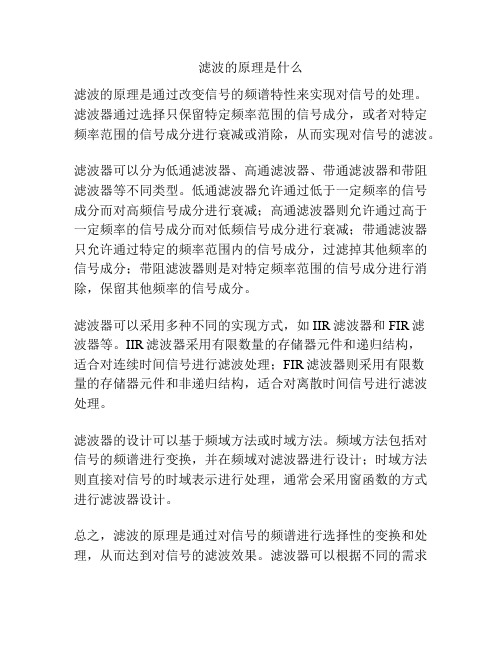
滤波的原理是什么
滤波的原理是通过改变信号的频谱特性来实现对信号的处理。
滤波器通过选择只保留特定频率范围的信号成分,或者对特定频率范围的信号成分进行衰减或消除,从而实现对信号的滤波。
滤波器可以分为低通滤波器、高通滤波器、带通滤波器和带阻滤波器等不同类型。
低通滤波器允许通过低于一定频率的信号成分而对高频信号成分进行衰减;高通滤波器则允许通过高于一定频率的信号成分而对低频信号成分进行衰减;带通滤波器只允许通过特定的频率范围内的信号成分,过滤掉其他频率的信号成分;带阻滤波器则是对特定频率范围的信号成分进行消除,保留其他频率的信号成分。
滤波器可以采用多种不同的实现方式,如IIR滤波器和FIR滤
波器等。
IIR滤波器采用有限数量的存储器元件和递归结构,
适合对连续时间信号进行滤波处理;FIR滤波器则采用有限数
量的存储器元件和非递归结构,适合对离散时间信号进行滤波处理。
滤波器的设计可以基于频域方法或时域方法。
频域方法包括对信号的频谱进行变换,并在频域对滤波器进行设计;时域方法则直接对信号的时域表示进行处理,通常会采用窗函数的方式进行滤波器设计。
总之,滤波的原理是通过对信号的频谱进行选择性的变换和处理,从而达到对信号的滤波效果。
滤波器可以根据不同的需求
选择合适的滤波器类型和设计方法,以实现对信号的滤波和处理。
用于亮色分离的梳状滤波器的研究
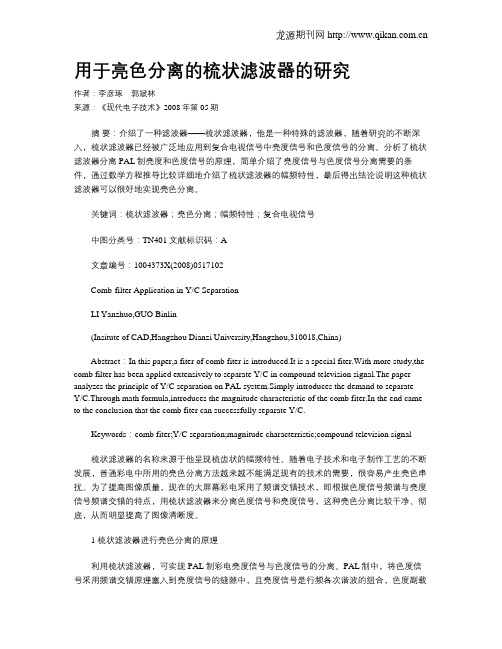
用于亮色分离的梳状滤波器的研究作者:李彦琢郭斌林来源:《现代电子技术》2008年第05期摘要:介绍了一种滤波器——梳状滤波器,他是一种特殊的滤波器,随着研究的不断深入,梳状滤波器已经被广泛地应用到复合电视信号中亮度信号和色度信号的分离。
分析了梳状滤波器分离PAL制亮度和色度信号的原理,简单介绍了亮度信号与色度信号分离需要的条件,通过数学方程推导比较详细地介绍了梳状滤波器的幅频特性,最后得出结论说明这种梳状滤波器可以很好地实现亮色分离。
关键词:梳状滤波器;亮色分离;幅频特性;复合电视信号中图分类号:TN401 文献标识码:A文章编号:1004373X(2008)0517102Comb-filter Application in Y/C SeparationLI Yanzhuo,GUO Binlin(Insitute of CAD,Hangzhou Dianzi University,Hangzhou,310018,China)Abstract:In this paper,a fiter of comb fiter is introduced.It is a special fiter.With more study,the comb filter has been applied extensively to separate Y/C in compound television signal.The paper analyzes the principle of Y/C separation on PAL system.Simply introduces the demand to separateY/C.Through math formula,introduces the magnitude characteristic of the comb fiter.In the end came to the conclusion that the comb fiter can successfully separate Y/C.Keywords:comb fiter;Y/C separation;magnitude characterristic;compound television signal梳状滤波器的名称来源于他呈现梳齿状的幅频特性。
累积梳状(CIC)滤波器分析与设计
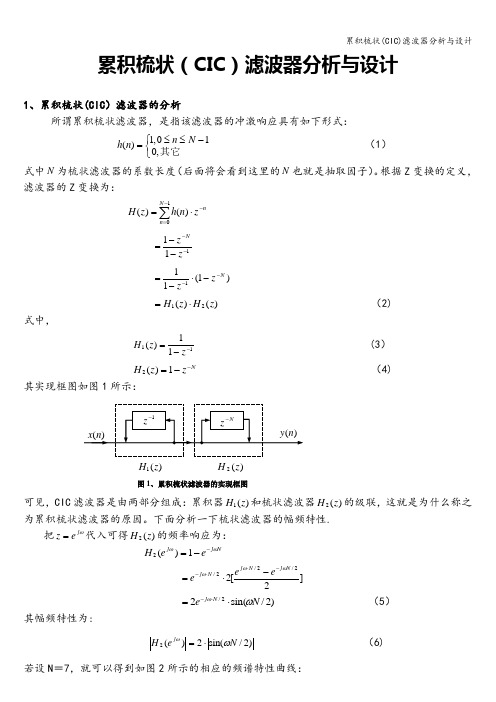
累积梳状(CIC )滤波器分析与设计1、累积梳状(CIC )滤波器的分析所谓累积梳状滤波器,是指该滤波器的冲激响应具有如下形式: ⎩⎨⎧-≤≤=其它,010,1)(N n n h (1)式中N 为梳状滤波器的系数长度(后面将会看到这里的N 也就是抽取因子)。
根据Z 变换的定义,滤波器的Z 变换为:∑-=-⋅=10)()(N n n z n h z H111----=z z N)1(111Nz z---⋅-=)()(21z H z H ⋅= (2) 式中,1111)(--=zz H (3) N z z H --=1)(2 (4) 其实现框图如图1所示:可见,CIC 滤波器是由两部分组成:累积器)(1z H 和梳状滤波器)(2z H 的级联,这就是为什么称之为累积梳状滤波器的原因。
下面分析一下梳状滤波器的幅频特性.把ωj e z =代入可得)(2z H 的频率响应为: N j j e e H ωω--=1)(2 ]2[22/2/2/N j N j N j e e eωωω-⋅⋅--⋅=)2/sin(22/N e N j ωω⋅=⋅- (5) 其幅频特性为:)2/sin(2)(2N e H j ωω⋅= (6) 若设N =7,就可以得到如图2所示的相应的频谱特性曲线:)(2z H)(1z H图1、累积梳状滤波器的实现框图由图2可以清楚地看到:)(2ωj e H 的形状犹如一把梳子,故把其形象地称之为梳状滤波器。
同样可以求得累积器)(1z H的频率响应为:ωj e z H --=11)(112/2/2/]2[2---=ωωωj j j e e e 12/)2(sin 2-⋅=ωωj e (7) 故CIC 滤波器的总频率响应为:)()()(21ωωωj j j e H e H e H ⋅= )2/sin(/)2/sin(ωωN = )2()2(1ωω-⋅⋅=Sa NSa N (8)式中,x x x Sa /)sin()(=为抽样函数,且1)0(=Sa ,所以CIC 滤波器在0=ω处的幅度值为N ,即:N e H j =)(0 (9)CIC 滤波器的幅频特性如图3所示:在)~0(π区间上称)/2~0(N π的区间为CIC 滤波器的主瓣,而其它区间称为旁瓣。
基于熔融拉锥法的MZI型梳状滤波器研究

基于熔融拉锥法的MZI型梳状滤波器研究王娜娜;余震虹;卜凡云;周冲【摘要】全光纤型的梳状滤波器(Interleaver)由于其优异的特性使之成为交叉复用技术的首选,而最简单的制作方法是通过熔融拉锥工艺制作M-Z干涉仪(MZI)型的Interleaver.但是其光谱形状的顶端平坦,隔离度和温漂等特性是该器件实用化必须解决的问题.从器件的实用角度出发,研究渡分复用器件中M-Z干涉仪的制作方法、原理及应用现状和存在的问题.同时针对存在的问题介绍了几种新颖的改进结构以及其输出光谱特性,这些设计无疑对Interleaver的成熟商用起着极大的推动作用.%Fiber type comb filter(lnterleaver) has become the first crossing multiplexing technique due to its excellent properties , and the simplest method is MZI based on the fused biconical taper. But the flat top, isolation and temperature drift characteristics of its spectrum are the practical problems must be solved. Froro perspective of the device's practical application,the manufacture, principle, application situation and the existing problems of Mach-Zehnder interferometer are studied. Some novel improved structure and its output spectrum are put forward in accordance with the existed problems. These designs of Interleaver can play a great role in promoting the mature commercial action.【期刊名称】《现代电子技术》【年(卷),期】2011(034)008【总页数】3页(P161-163)【关键词】Interleaver;M-Z干涉仪;熔融拉锥;输出光谱;顶端平坦【作者】王娜娜;余震虹;卜凡云;周冲【作者单位】江南大学,物联网工程学院,江苏,无锡,214122;江南大学,物联网工程学院,江苏,无锡,214122;江南大学,物联网工程学院,江苏,无锡,214122;江南大学,物联网工程学院,江苏,无锡,214122【正文语种】中文【中图分类】TN253-340 引言在2000年的3月OFC展览上,多家公司纷纷提出一种群组滤波器,Chroum公司称之为Slicer,Wavesplitter,JDS Uniphase等公司称之为Interleaver。
深入分析梳状滤波器原理Combfil课件

Y
Y
C
Y’ C’
Mode A (detection (1,3) > T3)
Which means the vertical detail defference is serious.
Bandpass filter performs better than comb filter.
Y
Mode B (detection (1,3) < T3)&(detection (2,3) > T2)
dominates.
Mode D
Conclusion
2D,3D,adaptive 2D.
Academic : adaptive 2D comb filter (less gate count ,more strategy).
Earn money : 3D/2D switch (best performance ,largest area)
An improved 2D adaptive comb filter
Overview (mode A,B,C,D)
Mode A (does not perform comb filtering)
Only when video image has serious vertical difference.
Notch/bandpass filter system
significant overlap , energy go through.
Chrominance phase difference
chroma burst reference and the chroma information is reversed by 180 degrees on alternate lines (luminance of the system to remain
滤波器原理简介
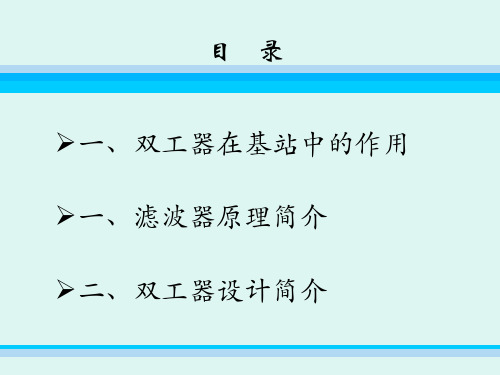
谐振器模型(过滤单元)
左图为单个谐振腔的电场模型及其等 效电路原理图。
图为不带圆盘的谐振杆的圆腔谐振器, 谐振杆顶部与盖板形成的电容,可以 理解成等效电路中的端接电容。
等效电路中的谐振频率计算公式为:
f
1
为谐振杆加入圆盘,相当于 加大了端接电容,圆盘越大,电 容越大,谐振频率越低; 同样加入调谐螺杆,也相当 于加大端接电容,螺杆进得越深, 端接电容值越大,谐振频率越低。 所以,将所有的调谐螺杆往 里进,则滤波器通带低偏。
滤波器抽头模型(阀门)
抽头为带通滤波器的馈电 装置。其结构关系到馈电强 度,以及与外部接口的匹配,
不同带宽,不同种类的滤波器 所用到的抽头是不一样的。总 的来讲有两种形式: 电耦合:通过电流或者电场 来进行耦合。 磁耦合:通过磁场进行耦合, 也称感性耦合。
a
b
对于同轴谐振器带通滤波 器,必须将输入/输出端的 抽头都设计到位,才能保证 通带驻波较小。不合理的抽 头设计,会导致输入能量较 多被反射,S11较大,驻波调 不下来,通带插损增大。
c
金属同轴滤波器的电耦合方式有两种,一种是探针耦合(b),一 种是直接馈电耦合(a)。 对于a中抽头,通过壁电流直接馈电,可以适用于带宽较宽的情况 ,结构稳定性好,是最常用的一种抽头方式。 对于b中的探针馈电方式,通过电场使得外部电路和第一个谐振腔 进行耦合,可以适用于窄带情况下,结构稳定性不好,不常用。 对于c中的磁耦合方式,一般适用于窄带滤波器,结构可靠性高, 但装配不方便。
以WCDMA的一个产品为例介绍滤波器的设计流程
谢 谢!
2012-9-7
29
容飞结构
感飞结构
容飞
感飞
几种传输零点
图为三种传输零点的响应。 传输零点可以增加相应频点的S12衰减。飞杆越强,则零点越靠近通带;飞 杆越弱,则零点越远离通带。
无创胎儿心电信号提取算法研究

无创胎儿心电信号提取算法研究杨雨丹;黄艺格;贺知明【摘要】介绍了无创采集的胎儿心电信号的主要特点,总结归纳了自适应滤波法、独立成分分析、人工神经网络、小波变换法、贝叶斯滤波法等5种无创胎儿心电信号提取算法及其相关改进算法的基本原理及研究现状,分析了5种算法各自的导联方式及其优缺点.指出了未来胎儿心电信号提取应考虑到多胞胎的问题,在提高算法实时性和精确性的前提下,研究便携式胎心监护设备,从而使胎儿心电监护走向个人化和家庭化.%The main characteristics were introduced for the fetal electrocardiogram by noninvasive collection. The basic principles and the research status were summarized of five algorithms and their related improvement algorithms for noninvasive fetal ECG signal extraction.The mode of electrodes,advantages and disadvantages were analyzed for kinds of algorithms.It's pointed out that multiple births should be taken into account for fetal ECG signals extraction in the future.The portable fetal cardiac monitoring device should be studied in case the real-time and accuracy of algorithms can be improved, making the baby's electrical monitoring to be personalized and family-friendly. [Chinese Medical Equipment Journal, 2018,39(5):97-102]【期刊名称】《医疗卫生装备》【年(卷),期】2018(039)005【总页数】6页(P97-102)【关键词】胎儿心电信号;无创采集;提取算法;胎心监护;心脏疾病【作者】杨雨丹;黄艺格;贺知明【作者单位】电子科技大学广东电子信息工程研究院,广东东莞523808;电子科技大学广东电子信息工程研究院,广东东莞523808;电子科技大学广东电子信息工程研究院,广东东莞523808【正文语种】中文【中图分类】R318;R540.4+10 引言心脏缺陷是最常见的胎儿先天病之一,也是导致胎儿死亡的主要原因之一。
一种基于梳状滤波器原理的重频跟踪方法
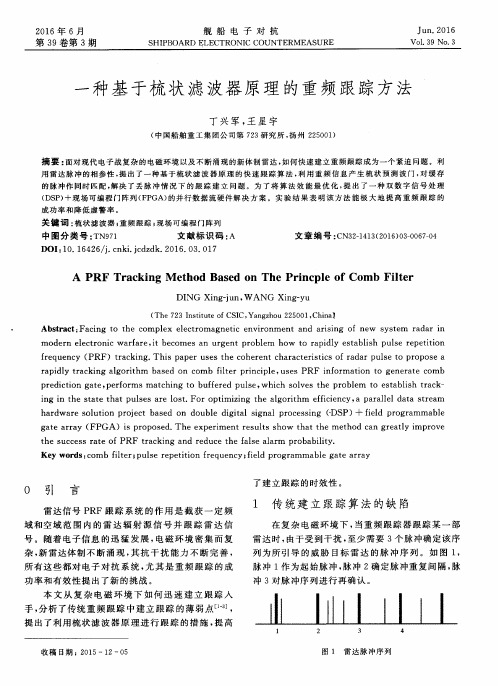
本 文 从 复 杂 电磁 环 境 下 如 何 迅 速 建 立 跟 踪 人 手 ,分 析 了传统 重 频 跟 踪 中建 立 跟 踪 的 薄 弱 点口 ], 提 出 了利用 梳状 滤 波 器 原 理 进 行 跟 踪 的措 施 ,提 高
了建立 跟踪 的时 效性 。
1 传 统 建 立 跟 踪 算 法 的缺 陷
2
3
4
收稿 日期 :2015—12一O5
图 1 雷 达 脉 冲 序 列
68
舰 船 电 子 对 抗
第 39卷
针对 这 个 建 立 跟踪 的逻 辑 ,当前 主流 算 法都 是 脉 冲 1到达 时首先 触 发 半 波 门产生 电路 ,产 生 1个 半波 门信 号 ,首 脉 冲 控 制 电 路 给 出 脉 冲 重 复 频 率 (PRF),计数 电路 采用 减计 数方 式工 作 ,当减 为 零 时 输 出控 制信号 ,控制 波 门产 生 电路 产生 波 门 。波 门 产生 后 ,首脉 冲控 制 电路 判 断波 门 内是否有 脉 冲 ,若 有脉 冲则 进入 正 常跟 踪 状 态 ;若 没 有 脉 冲 则 重新 进 行首 脉 冲捕捉 。进入 正 常 跟 踪 状 态后 ,需 要 连续 正 确捕 捉 到一 定 数 量 脉 冲 数 后 (最 低 1个 ,例 如 脉 冲 3)建 立跟 踪 ,才 准许 对 外 输 出跟 踪 波 门 。这 种算 法 在 简单 电磁 环境 下很 有 效 ,但 在 复杂 电磁 环 境 下则 很难 建 立跟 踪 。如 图 2,虚 线 为 缺 失 脉 冲 。接 收 机 由于灵 敏度 或者 同时 到达 信号 等原 因 出现丢 脉 冲现 象 ,没有 连续 的重 频 间隔 ,按照 当前 算法则 很 难建 立 跟 踪 。在 作 战情 况 下 ,每个 脉 冲 都 很 珍 贵 ,如若 不 慎 ,容 易贻误 战机 。
c语言实现cic梳状滤波__理论说明
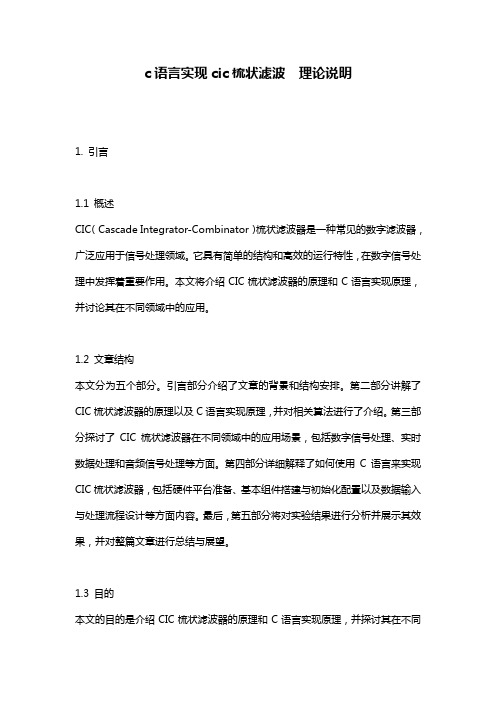
c语言实现cic梳状滤波理论说明1. 引言1.1 概述CIC(Cascade Integrator-Combinator)梳状滤波器是一种常见的数字滤波器,广泛应用于信号处理领域。
它具有简单的结构和高效的运行特性,在数字信号处理中发挥着重要作用。
本文将介绍CIC梳状滤波器的原理和C语言实现原理,并讨论其在不同领域中的应用。
1.2 文章结构本文分为五个部分。
引言部分介绍了文章的背景和结构安排。
第二部分讲解了CIC梳状滤波器的原理以及C语言实现原理,并对相关算法进行了介绍。
第三部分探讨了CIC梳状滤波器在不同领域中的应用场景,包括数字信号处理、实时数据处理和音频信号处理等方面。
第四部分详细解释了如何使用C语言来实现CIC梳状滤波器,包括硬件平台准备、基本组件搭建与初始化配置以及数据输入与处理流程设计等方面内容。
最后,第五部分将对实验结果进行分析并展示其效果,并对整篇文章进行总结与展望。
1.3 目的本文的目的是介绍CIC梳状滤波器的原理和C语言实现原理,并探讨其在不同领域中的应用场景。
通过详细解释C语言实现CIC梳状滤波器的步骤,读者可以加深对该滤波器的理解,并了解如何将其应用于具体项目中。
最后,通过对实验结果进行分析与总结,读者可以评估CIC梳状滤波器在不同场景下的性能表现,并对其未来发展进行展望。
2. 理论基础:2.1 CIC梳状滤波器原理CIC(Cascade Integrator-Comb)梳状滤波器是一种常用的数字信号处理滤波器,用于对离散时间序列进行低通滤波。
它由级联部分积分器和组合部分组成。
CIC梳状滤波器的输入信号首先经过M个阶数为R的积分级,在每一级中累加了M个输入样本,然后被一个差分延时线延时M/R个采样周期。
延时后的信号经过一个减法运算,乘以一个增益因子D,并通过R级组合部分,其中每一级包含一个差分延时线和一个减法运算单元。
最终输出结果是经过R级积分之后的信号。
2.2 C语言实现原理在C语言中实现CIC梳状滤波器需要定义相应的数据结构和函数来实现不同模块之间的连接和数据处理。
滤波器工作原理
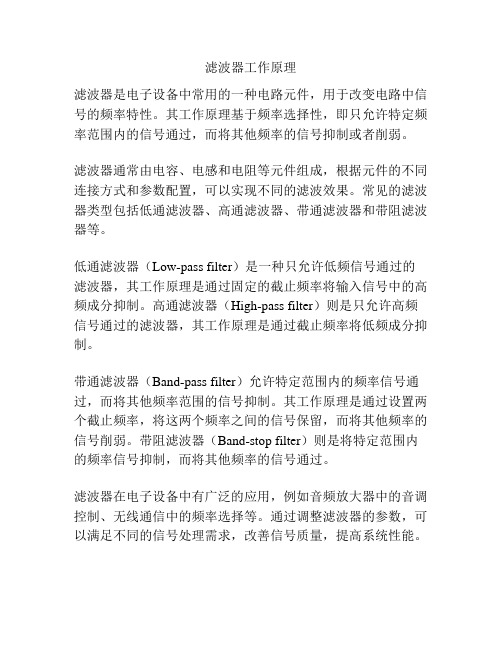
滤波器工作原理
滤波器是电子设备中常用的一种电路元件,用于改变电路中信号的频率特性。
其工作原理基于频率选择性,即只允许特定频率范围内的信号通过,而将其他频率的信号抑制或者削弱。
滤波器通常由电容、电感和电阻等元件组成,根据元件的不同连接方式和参数配置,可以实现不同的滤波效果。
常见的滤波器类型包括低通滤波器、高通滤波器、带通滤波器和带阻滤波器等。
低通滤波器(Low-pass filter)是一种只允许低频信号通过的滤波器,其工作原理是通过固定的截止频率将输入信号中的高频成分抑制。
高通滤波器(High-pass filter)则是只允许高频信号通过的滤波器,其工作原理是通过截止频率将低频成分抑制。
带通滤波器(Band-pass filter)允许特定范围内的频率信号通过,而将其他频率范围的信号抑制。
其工作原理是通过设置两个截止频率,将这两个频率之间的信号保留,而将其他频率的信号削弱。
带阻滤波器(Band-stop filter)则是将特定范围内的频率信号抑制,而将其他频率的信号通过。
滤波器在电子设备中有广泛的应用,例如音频放大器中的音调控制、无线通信中的频率选择等。
通过调整滤波器的参数,可以满足不同的信号处理需求,改善信号质量,提高系统性能。
深入分析梳状滤波器原理Comb-filter共28页文档
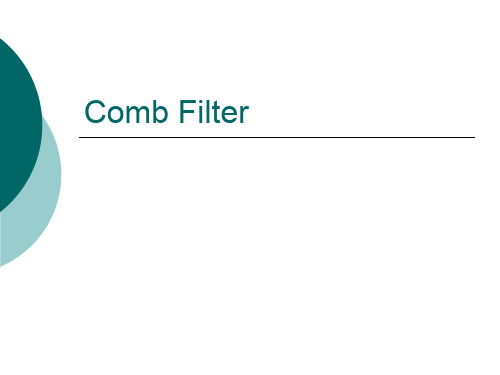
Problems
Vertical detail difference (adjacent lines).
Motion difference (adjacent frames).
Adaptive comb filter 1.Detect and select one form. 2.Correction terms. 3.Weighting and sum .
Use under that 3 lines are so close. Can separate better than B.
Mode D (2D simple comb filter)
Use under that detection(2,3) dominates.
Common method for difference detection
Horizontal delay
analog: glass delay line , CCD . digital : memory .
3D comb filter
compare information in successive frames .(odd) perfect separation of Y and C for still frame images
y y+c
y-c
2c
c
Why we call it a "comb filter"
2D weighting comb filter
different colors vertically through the picture . (1/4,1/2,1/4). the transition from one color to another is softened.docin/sanshengshiyuan doc88/sanshenglu
深入分析梳状滤波器原理Comb-filter-PPT资料28页
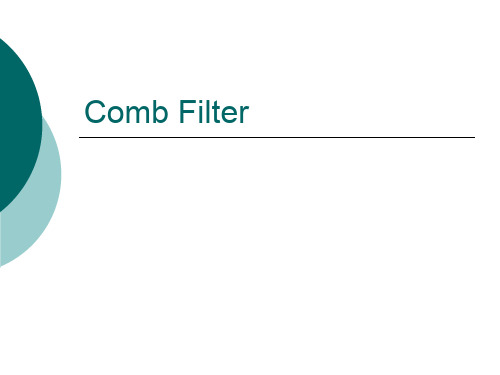
little difference between Y.
Y
Mode C (detection (1,3) < T1)&(detection (2,3) < T2)
(composite)
NTSC composite signal
Video signal prepared for broadcast contains two major parts, the luminance (Y) and chrominance (C).
Basic concept for Y C separate
( key advantage over the 2D filter ). motion or serious color changes , 3D filter may
perform no better than the 2D filter. has to store two frames of video data.
Comb Filter
Outline
Y-C separation 2D comb filter 3D comb filter 2D adaptive comb filter conclusion
Comb filter (Y-C separator)
Separate the incoming composite video signal into luminance (Y) and chrominance (C).
Reference
dominates.
一种基于FPGA的高精度数字鉴相器

一种基于FPGA的高精度数字鉴相器贺为婷;裴广利【摘要】本文提出一种基于CIC滤波器和CORDIC算法的高精度数字鉴相器.本鉴相器通过两路正交本振信号分别与两路待测相信号相乘,使用CIC滤波器的滤除乘积中的高频信号,最后通过CORDIC算法计算出相位差.上述方法适于FPGA实现,Alteral公司的FGPA有丰富的乘法器资源,并且可以通过增加数据位宽度和使用流水线来实现鉴相器的高精度性和高速度性.通过modelsim和matlab的联合功能仿真,在加入一路35dB的高斯白噪声的信号中进行30次测量最大误差小于0.0032 rad.%A method based on CIC filter and the CORDIC algorithm for high accuracy digital phase discriminator is presented. First of all, the two orthogonal local oscillator signals generated by FPGA are respectively multiplied by two measured signals. Then, the phase demodulator use CIC filter to filter high frequency signal of the product. Last, the CORDIC algorithm calculates the phase difference. FPGA is fit to complete the design. The al-teral company' s FPGA has rich multiplier resources and can increase the data bit width and use the pipeline to achieve phase for the high precision and high speed. The maximum error is less than 0. 003 2 rad of 30 measures adding 35 dB Gauss white noise to one signal, through the Modelsim and Matlab joint function simulation.【期刊名称】《科学技术与工程》【年(卷),期】2012(012)030【总页数】6页(P8047-8051,8057)【关键词】FPGA;CIC滤波器;CORDIC算法【作者】贺为婷;裴广利【作者单位】西安工业大学电子信息工程学院,西安710032;西安工业大学电子信息工程学院,西安710032【正文语种】中文【中图分类】TN7633;TN79.1激光测距是随着激光技术的发展而发展起来的一种高精度测距技术。
液晶电视万能通用主板详解
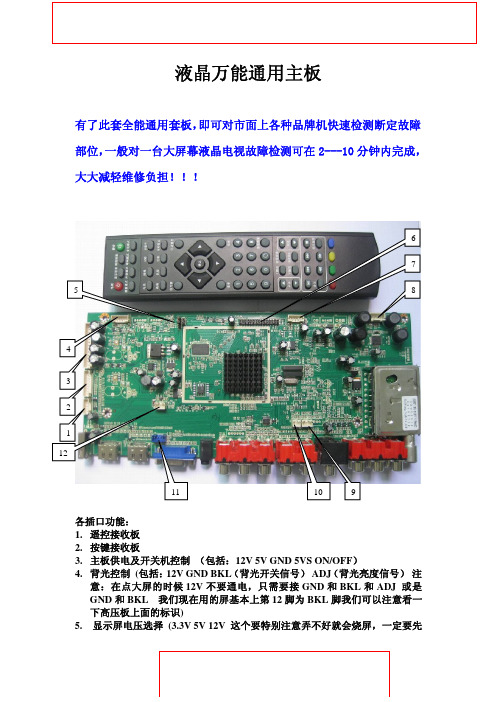
液晶万能通用主板有了此套全能通用套板,即可对市面上各种品牌机快速检测断定故障部位,一般对一台大屏幕液晶电视故障检测可在2---10分钟内完成,大大减轻维修负担!!!各插口功能:1.遥控接收板2.按键接收板3.主板供电及开关机控制(包括:12V 5V GND 5VS ON/OFF )4.背光控制(包括:12V GND BKL (背光开关信号)ADJ (背光亮度信号)注意:在点大屏的时候12V 不要通电,只需要接GND 和BKL 和ADJ 或是GND 和BKL 我们现在用的屏基本上第12脚为BKL 脚我们可以注意看一下高压板上面的标识)5.显示屏电压选择(3.3V 5V 12V 这个要特别注意弄不好就会烧屏,一定要先786查清楚你所要点的屏上电电压)6.LVDS屏线(屏线不能插反或是插错,不然会引起烧板或是烧屏,注意屏线的电源一头应插在长方形的角有个一缺口的那一端,或是打有白点的那一端)7.接口功能未开通8.喇叭接口9.接口功能未开通10.接口功能未开通11.主板程序写入接口12.接口功能未开通万能液晶驱动板主板特点:此液晶驱动主板可以从:5.6寸直接点到65寸,不管你是高分低分,只需要一个高分程序和一个低分程序即可搞定(建议买家够买两套此液晶主板,一板写高分程序,一板写低分程序这样用起来更方便),目前我这还有一种液晶主板不论高分低分屏,可全部通过遥控器来操作,不用因屏不同而又要重新烧录程序。
但是我不建议大家买这样的板,虽然不用重新写程序,但是你每次点一个高分屏或是一个低分屏后,再点另一种屏时,又得用遥控器进总线进行程序的改写,有时候还改写不成功,造成我们以为屏坏的错觉,所以我建议大家也不是为了省那么100多块钱而去影响我们的工作效率。
此主板带了现在主流的HDMI高清接口两路,一路AV输出和输入,两路高清分量信号输入,一路S端子,一路RF,和一路声音带来听觉震撼的同轴声音输出,给我们带来不一样的听觉效果。
梳状滤波器详述

5
原型低通滤波器机仿真结果
6
K变换器或J变换器
把LC低通原型变换成只有一种电感元件或只有一种电容元件的低通原型, 称之为变形低通原型。 在LC梯形低通原型的各元件间加入K变换器把电容变换成电感,最后得到只 有电感的低通原型。 在LC梯形低通原型的各元件间加入J变换器把电感变换成电容,最后得到只 有电容的低通原型。
Ls L1 ; Cs C1 r r
把ω =1;L1=1和C1=1代入上式,得:
Ls
18
1
r
1 2 f r
Henry; Cs
1
r
1 2 f r
Farad
带通滤波器
ZL=1
其中:
1 1 1 1 Ls Henry; Cs Farad r 2 f r r 2 f r
15
对bw去归一化变形低通原型滤波器
ZL=1
16
归一化带通滤波器
在前面的对bw去归一化低通原型滤波器中用1H电感和1F电 容组成的串联谐振回路代替原来的1H电感。就构成了一个谐 振频率为1Hz,相对带宽为bw的归一化带通滤波器
g0 = 1 1 1 1
ZL=1
g1 g2
gi gj
~
bw / g1
1
滤波器设计
1
设计实例-2
梳状滤波器设计
2
滤波器技术参数
滤波器要求的技术参数; 中心频率;400MHz;
带宽:15MHz;
带内波动:小于0.1dB 带外抑制度:偏离中心频率25MHz;大于40dB;
初步确定采用Chebyshev型7阶梳状滤波器
3
低通原型滤波器(查出标准化G值)
4
建立低通原型滤波器电路模型
- 1、下载文档前请自行甄别文档内容的完整性,平台不提供额外的编辑、内容补充、找答案等附加服务。
- 2、"仅部分预览"的文档,不可在线预览部分如存在完整性等问题,可反馈申请退款(可完整预览的文档不适用该条件!)。
- 3、如文档侵犯您的权益,请联系客服反馈,我们会尽快为您处理(人工客服工作时间:9:00-18:30)。
NTSC composite signal
Video signal prepared for broadcast contains two major parts, the luminance (Y) and chrominance (C).
Basic concept for Y C separate
Problems
Vertical detail difference (adjacent lines).
Motion difference (adjacent frames).
Adaptive comb filter 1.Detect and select one form. 2.Correction terms. 3.Weighting and sum .
Just a bandpass filter.
Mode B (2D weighting with bandpass filter)
Normal mode ,Y-C can be separated quite well.
Mode C (2D weighting without bandpass filter)
Check Y signal only. Switch mode when difference exceeds a
threshold value.
Detection algorithm
Normal way (upper). Special detection (bottom). Use these two detections. (T1,T2,T3)
An improved 2D adaptive comb filter
Overview (mode A,B,C,D)
Mode A (does not perform comb filtering)
Only when video image has serious vertical difference.
Use under that 3 lines are so close. Can separate better than B.
Mode D (2D simple comb filter)
Use under that detection(2,3) dominates.
Common method for difference detection
1.Frequency- notch , bandpass filter ( in early years ).
2.Chrominance phase differencecomb filter ( today ).
Frequency
Luminance & chrominance frequency
constant[ monochrome receivers]).
180 degrees
2D comb filter
Important concept…picture information (y , c) is about the same from line to line .
Special case( y - c , y + c ).
Notch/bandpass filter system
significant overlap , energy go through.
Chrominance phase difference
chroma burst reference and the chroma information is reversed by 180 degrees on alternate lines (luminance of the system to remain
y y+ c
y -c
ห้องสมุดไป่ตู้
2c
c
Why we call it a "comb filter"
2D weighting comb filter
different colors vertically through the picture . (1/4,1/2,1/4). the transition from one color to another is softened.
Y
Y
C
Y’ C’
Mode A (detection (1,3) > T3)
Which means the vertical detail defference is serious.
Bandpass filter performs better than comb filter.
Y
Mode B (detection (1,3) < T3)&(detection (2,3) > T2)
Horizontal delay
analog: glass delay line , CCD . digital : memory .
3D comb filter
compare information in successive frames .(odd) perfect separation of Y and C for still frame images
( key advantage over the 2D filter ). motion or serious color changes , 3D filter may
perform no better than the 2D filter. has to store two frames of video data.
Comb Filter
Outline
Y-C separation 2D comb filter 3D comb filter 2D adaptive comb filter conclusion
Comb filter (Y-C separator)
Separate the incoming composite video signal into luminance (Y) and chrominance (C).
